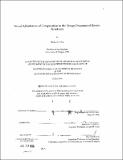Novel affordances of computation to the design processes of kinetic structures
Author(s)
Fox, Michael A. (Michael Allan)
DownloadFull printable version (4.587Mb)
Advisor
Takehiko Nagakura.
Terms of use
Metadata
Show full item recordAbstract
This paper is a discourse into the relationship between the process, computational tools and the role which symbolic structure can play in both. I argue the relationship of the process and tools is dialectic, whereby the tools we utilize in design develop new heuristics, the methodologies in tum, if reflectively understood, can be more aptly facilitated through the development of novel tools. The tools and the process then evolve together. A theory is laid out exploring the human visual information processing systems pertinence to the limitations in mental three-dimensional imaging and transformation operations relevant to the operations of drawing and mental visualization within the architectural design processes, substantiating the designers "necessity" to d raw (by traditional means, but more importantly here, through the inclusive integration of CAD within the process). The "necessity" to draw is explored as a re-presentational process to the visual system predicated upon the existence of a structured internal "library" of diagram-like representations. I argue that the ways we utilize such idiosyncratic libraries is predicated upon the ways in which we go about structuring the perceived "experienced" world around us into "symbol systems". And finally, the ways we utilize our reflective understanding of the heuristic transformations of these "symbols" within the design process in the context of a CAD environment are explored as a means to an enhanced understanding of that which is being designed and consequently as a vehicle for the development of future CAD systems to better facilitate such methodologies of designing. A personal design process of several kinetic structures is carried out in order to arrive at a localized process analysis within computer-aided design environment. Through an interactive, reflective process analysis, conclusions are drawn as to the affordances and limitations of such tools as suggestive of the operations a CAD environment might perform so as to better foster future methodologies of designing. The design "experiments" are utilized as a vehicle to understand the process. Specifically three kinetic projects are exploited for the prototypical "operations" they display. When difficulties or mental limitations are encountered with the operations, specific "tools" are developed to facilitate the limitation or to overcome the problem.
Description
Thesis (M.S.)--Massachusetts Institute of Technology, Dept. of Architecture, 1996. Includes bibliographical references (leaves 44-45).
Date issued
1996Department
Massachusetts Institute of Technology. Department of ArchitecturePublisher
Massachusetts Institute of Technology
Keywords
Architecture